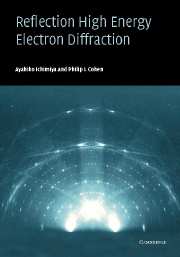Book contents
- Frontmatter
- Contents
- Preface
- 1 Introduction
- 2 Historical survey
- 3 Instrumentation
- 4 Wave properties of electrons
- 5 The diffraction conditions
- 6 Geometrical features of the pattern
- 7 Kikuchi and resonance patterns
- 8 Real diffraction patterns
- 9 Electron scattering by atoms
- 10 Kinematic electron diffraction
- 11 Fourier components of the crystal potential
- 12 Dynamical theory – transfer matrix method
- 13 Dynamical theory – embedded R-matrix method
- 14 Dynamical theory – integral method
- 15 Structural analysis of crystal surfaces
- 16 Inelastic scattering in a crystal
- 17 Weakly disordered surfaces
- 18 Strongly disordered surfaces
- 19 RHEED intensity oscillations
- Appendix A: Fourier representations
- Appendix B: Green's functions
- Appendix C: Kirchhoff's diffraction theory
- Appendix D: A simple eigenvalue problem
- Appendix E: Waller and Hartree equation
- Appendix F: Optimization of dynamical calculation
- Appendix G: Scattering factor
- References
- Index
8 - Real diffraction patterns
Published online by Cambridge University Press: 06 July 2010
- Frontmatter
- Contents
- Preface
- 1 Introduction
- 2 Historical survey
- 3 Instrumentation
- 4 Wave properties of electrons
- 5 The diffraction conditions
- 6 Geometrical features of the pattern
- 7 Kikuchi and resonance patterns
- 8 Real diffraction patterns
- 9 Electron scattering by atoms
- 10 Kinematic electron diffraction
- 11 Fourier components of the crystal potential
- 12 Dynamical theory – transfer matrix method
- 13 Dynamical theory – embedded R-matrix method
- 14 Dynamical theory – integral method
- 15 Structural analysis of crystal surfaces
- 16 Inelastic scattering in a crystal
- 17 Weakly disordered surfaces
- 18 Strongly disordered surfaces
- 19 RHEED intensity oscillations
- Appendix A: Fourier representations
- Appendix B: Green's functions
- Appendix C: Kirchhoff's diffraction theory
- Appendix D: A simple eigenvalue problem
- Appendix E: Waller and Hartree equation
- Appendix F: Optimization of dynamical calculation
- Appendix G: Scattering factor
- References
- Index
Summary
Measured diffraction patterns exhibit a range of features, depending upon the degree of surface and subsurface perfection. Low-index Si surfaces and smooth GaAs surfaces prepared by MBE can show near-ideal behavior, while epitaxial films of GaN can be weak and diffuse or show features reminiscent of transmission electron diffraction. Even so, these patterns are often interpretable without analysis of the diffracted intensities, just with consideration of their geometrical aspects, as described in Chapter 6. One can not only determine the symmetries of atomic arrangements but also characterize the presence of some types of imperfections, the degree of surface roughness and the sizes of domains and terraces–in short, crucial information for many types of surface study. In this chapter we develop straightforward methods for analyzing patterns, giving a number of examples.
We will continue to use the Ewald construction described in Chapter 5, but now applied to samples with a range of domain sizes and domain orientations. This becomes complicated except for the simple case in which the incident beam is directed along a principal axis of a perfect surface. At off-symmetry conditions or for defected surfaces the patterns are often difficult to interpret. Off-symmetry incident azimuths are especially interesting, since for these the analysis of the diffracted intensities proves simpler and often they are the only azimuths available to a film grower. Misoriented surfaces, having been discussed in Section 6.4, will not be considered here.
- Type
- Chapter
- Information
- Reflection High-Energy Electron Diffraction , pp. 77 - 112Publisher: Cambridge University PressPrint publication year: 2004

